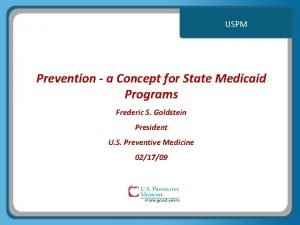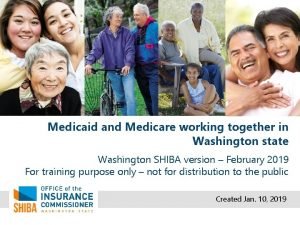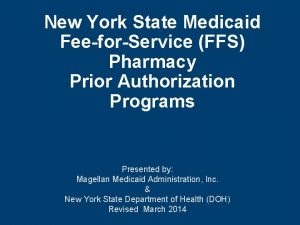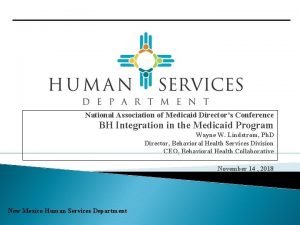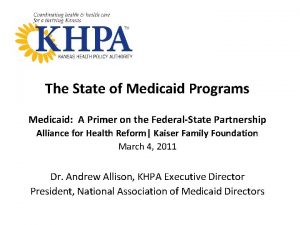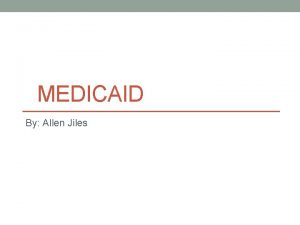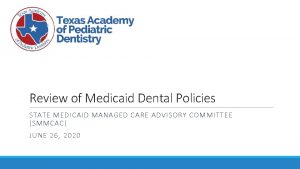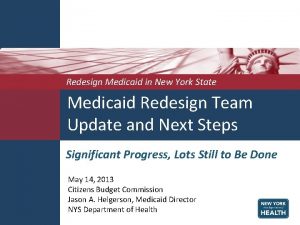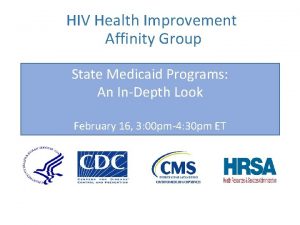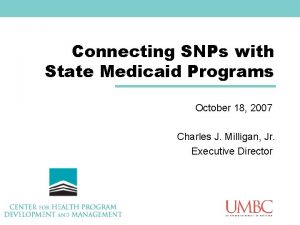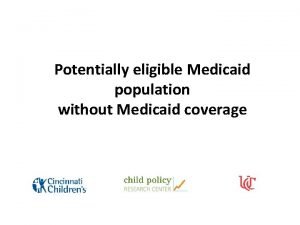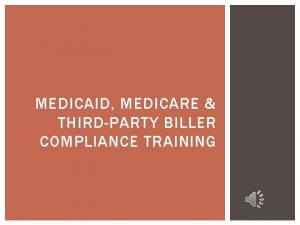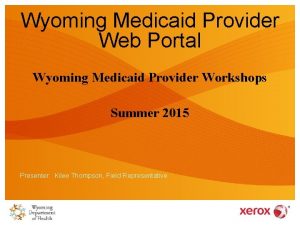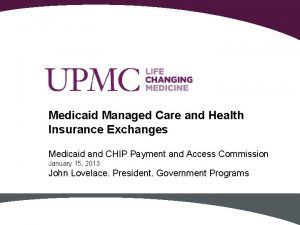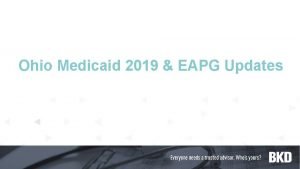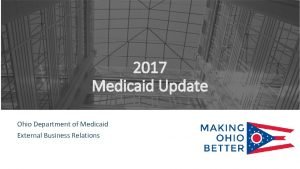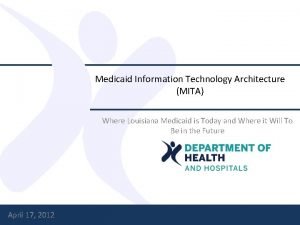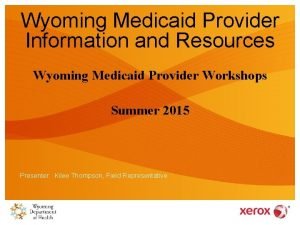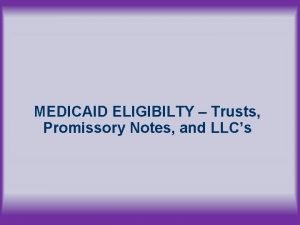USPM Prevention a Concept for State Medicaid Programs









































- Slides: 41

USPM Prevention - a Concept for State Medicaid Programs Frederic S. Goldstein President U. S. Preventive Medicine 02/17/09

USPM Agenda USPM Background The Current Health Care System How Prevention Works Ideas for Alaska

USPM Background Extensive experience in Health Plans, Hospitals, Chronic Care Management, Medicaid and Commercial Over 10 years of Medicaid Care Management experience Rural States Diverse populations Experience with NA/AI and IHS National and International Services

CREATING NEW PARADIGM Prevention is our only business From the top down, we have all lost family members too soon…we “walk the talk” Every USPM employee is on a mission to create real change in the healthcare system and to help individuals’ improve their long-term health

WHY PREVENTION? U. S. Preventive Medicine believes the answer is: A systematic approach that identifies those at risk now or in the future based on key clinical indicators Intervention with effective programs of education, behavior modification and care management Periodic measurement of clinical results to improve outcomes and reduce overall health care costs

Gov. Tommy Thompson joins as National Policy Advisor Gov. Tommy Thompson Former Secretary of HHS



WHAT IS PREVENTION Clinical Definition Primary Secondary Tertiary


OUR PRODUCT SUITE .


MANAGING THOSE USING THE MOST RESOURCES The Prevention Plan CM Heart Failures Diabetes Asthma COPD CAD Schizophrenia Bipolar disorders High risk maternity Sickle Cell Depression Hepatitis C HIV/AIDS Cancers • Breast • Cervical • Colon • Prostate

Health Cost Background

Chronic diseases are the #1 cause of death and disability in the U. S. 133 million Americans, representing 45% of the total population, have at least one chronic disease Chronic diseases kill more than 1. 7 million Americans per year, and are responsible for 7 of 10 deaths in the U. S. 1 15

Patients with chronic diseases account for 75% of the nation’s health care spending During 2005, the U. S. spent almost $2 trillion on health care Of every dollar spent… … 75 cents went towards treating patients with one or more chronic diseases In public programs, treatment of chronic diseases constitute an even higher portion of spending: More than 96 cents in Medicare… …and 83 cents in Medicaid “The United States cannot effectively address escalating health care costs without addressing the problem of chronic diseases. ” -- Centers for Disease Control and Prevention 1 16

Two-thirds of the increase in health care spending is due to increased prevalence of treated chronic disease Level 0 f health spending among the noninstitutionalized U. S. population, 1987– 2000 (in billions of nominal dollars) $313. 5 ~$211 billion Years $627. 9 = Increase attributable to rise in prevalence of treated chronic disease 1 17

The doubling of obesity between 1987 and today accounts for nearly 30% of the rise in health care spending Percent of U. S. Adults Who are Obese* 1985 No data <10% 10%-14% *BMI ≥ 30, or ~ 30 lbs overweight for 5’ 4” person 1 18

The doubling of obesity between 1987 and today accounts for nearly 30% of the rise in health care spending The percent of children and youth who are overweight has tripled since 1980 No data If the prevalence of obesity was the same today as 1987, health care spending in the US would be 10 percent lower person— about $200 billion less Percent of U. S. Adults Who are Obese* 2005 <10% 10%-14% *BMI ≥ 30, or ~ 30 lbs overweight for 5’ 4” person 15%-19% 20%-24% 25%-29% >30% 1 19

The vast majority of cases of chronic disease could be better prevented or managed • The Centers for Disease Control and Prevention (CDC) estimates… • 80% of heart disease and stroke • 80% of type 2 diabetes • 40% of cancer …could be prevented if only Americans were to do three things: ü Stop smoking ü Start eating healthy ü Get in shape • Management of chronic disease could also be significantly improved: Chronically ill patients receive only 56% of the clinically recommended preventive health care services 2 20

THE CAUSE HEALTHCARE 1. 0 and 2. 0 doesn’t work and Current solutions are ineffective: Business as usual System set up to treat illness instead of prevent it Fragmented and superficial programs don’t engage eligible population: 7 -12% is the norm Unsuccessful in changing behavior No meaningful incentive for individuals to participate

WHAT CAN WE DO ABOUT IT One solution in sight: Milken Institute study finds Prevention Early detection Chronic condition management could save U. S. $1 trillion annually… “An Unhealthy America” 2007 study Nonprofit, nonpartisan economic think tank

MEDICAID Reforming the Medicaid Program Alaska is unique What has Alaska said they were looking towards Why Reform versus expansion Implementing a Prevention Based Model

ALASKA IS UNIQUE Alaska’s Unique Features Rural to the extreme which is affected by infrastructure (roads, facilities, etc. ) Diverse population, AN/AI Issues must be overcome through innovative uses of people, systems and technology.

STATE PRIORITIES Alaska Dept. of Health and Social Services – 2009 Priorities “ • Care Management: Improve care coordination; implement disease management program for chronic diseases and explore use of primary care case management strategy for most disabled populations; complete planning for the Bring the Kids Home Initiative. • Medicaid Reform: Develop legislative and systemic recommendations for reforming Medicaid aimed at improving Medicaid sustainability. ”

STATE PRIORITIES Alaska Health Care Strategies Planning Council Making Alaskans the healthiest people in the nation… Goal Five – Prevention and Personal responsibility The Council believes that government has an obligation to “jump start” healthy choices through incentives, and in addition build the necessary incentive structures for the future.

MEDICAID Reform Versus Expansion The current system is flawed it’s a sick care system. Why expand what is not working well? To maximize value, must change incentives for all players Through appropriate reform, one can find savings to expand eligibility (Medicaid funds in Stimulus bill? ) How? Bend the trend on the health status of the Medicaid beneficiaries

MEDICAID Some Issues to Understand Beneficiaries don’t have the knowledge to manage their care Providers don’t have the time, expertise, or systems Some states have tried pieces of the concept At the end of the day its about one person changing their behavior.

MEDICAID Recommendations Comprehensive Prevention Approach - 1⁰, 2⁰, 3⁰ Shared accountability – Incentives and Sticks Providers Beneficiaries Vendors Reform the payment system to providers

MEDICAID Comprehensive Prevention Approach - 1⁰, 2⁰, 3⁰ Baseline assessment of all beneficiaries Shared clinical information system, statewide Comprehensive support/advocacy/coaching for beneficiaries across the continuum Individualized plan for each beneficiary

MEDICAID Shared accountability – Incentives and Sticks Providers Beneficiaries Vendors

MEDICAID Reform the payment system to providers Pay for Preventive Services Incent outcomes Pay for data systems (Look to Stimulus package with funding for Heath IT. )

IDEAS Specific Areas to Consider Care Management for Persons with Severe and Persistent Mental Illness – This could address Target #3: Reduce 30 -day readmission rate for Alaska Psychiatric Institute (API) to 10 percent, which was at 13. 5% in 2007 Implement a comprehensive prevention program to address Target #1: 80 percent of all 2 -year-olds are fully immunized, which was at 67. 3% in 2007. Implement a High Risk Maternity Care Management program Target #2: Reduce post-neonatal death rate to 2. 7 per 1, 000 live births by 2010. Targets from FY 2009 DHSS Overview

MEDICAID Examples of Success in Medicaid Program examples Some state ideas

MEDICAID RESULTS High Risk Maternity Preterm babies cost an average of $32, 000 in Medical costs during their first year. (March of Dimes). Medicaid tends to have a higher proportion of pre-term births. USPM high risk mothers experienced a 9. 4% preterm delivery rate versus a 14. 8% county average. Program cost $350, 000, Estimated gross savings >$900, 000. Another State program experienced a 14. 0% preterm delivery rate versus a 20% county average.

MEDICAID RESULTS Clinical Improvements Mental Illness costs disproportionately fall within Medicaid, particularly for those living with Severe and Persistent Mental Illness. USPM members in a program for Persons with Schizophrenia experienced a 54% reduction in per member per month costs for ER visits. In the same program medication adherence to appropriate antipsychotics improved with fill rates going from 22. 9 days per month in year 1 to 27. 9 days per month in year 2. (30 days would be 100% adherence to filling medications)

MEDICAID RESULTS Program outcomes for persons with adult and pediatric asthma, CAD, COPD, diabetes, heart failure, adult and pediatric sickle cell, and adult depression, schizophrenia, schizoaffective and bipolar disorder

MEDICAID RESULTS Clinical Improvements Chronic Care costs for heart failure, COPD and diabetes are high and these conditions require extensive self management skills

QUALITY IMPROVEMENTS Quality Improvements Quality Measure At Assessment At 6 Months Foot Exams (diabetes) 12% 65% A 1 c tests (diabetes) 47% 100% Monitor blood pressure (hypertension) 14% 32% Asthma Action Plan 26% 93%

Other State Ideas: Incentives: a number of States are exploring putting more control into the hands of the beneficiaries with incentives that they can earn by doing the right thing. Telemonitoring: In home monitoring devices for high cost clients, data managed daily. E prescribing: Better control of prescriptions, reduces inappropriate utilization, improves safety.

IN CLOSING What the State says By improving the place of prevention and personal responsibility in the health and health care decision-making rubric of Alaskans, costs of health care could be lower than they otherwise would be. With concentration on a wellness model of health care, as well as state support for the Community Health Center system and a robust public nursing program, the current access problems could be significantly reduced. Alaska Health Care Strategies Planning Council, December 23, 2007
 Primary prevention secondary prevention tertiary prevention
Primary prevention secondary prevention tertiary prevention Uspm
Uspm Prevnet
Prevnet Collection of programs written to service other programs.
Collection of programs written to service other programs. Shiba rainbow chart
Shiba rainbow chart New york state medicaid prior authorization
New york state medicaid prior authorization National association of state medicaid directors
National association of state medicaid directors Washington state apprenticeship programs
Washington state apprenticeship programs Fspos vägledning för kontinuitetshantering
Fspos vägledning för kontinuitetshantering Novell typiska drag
Novell typiska drag Nationell inriktning för artificiell intelligens
Nationell inriktning för artificiell intelligens Vad står k.r.å.k.a.n för
Vad står k.r.å.k.a.n för Shingelfrisyren
Shingelfrisyren En lathund för arbete med kontinuitetshantering
En lathund för arbete med kontinuitetshantering Särskild löneskatt för pensionskostnader
Särskild löneskatt för pensionskostnader Vilotidsbok
Vilotidsbok Sura för anatom
Sura för anatom Vad är densitet
Vad är densitet Datorkunskap för nybörjare
Datorkunskap för nybörjare Boverket ka
Boverket ka Debattartikel struktur
Debattartikel struktur Delegerande ledarstil
Delegerande ledarstil Nyckelkompetenser för livslångt lärande
Nyckelkompetenser för livslångt lärande Påbyggnader för flakfordon
Påbyggnader för flakfordon Tryck formel
Tryck formel Publik sektor
Publik sektor Jag har nigit för nymånens skära text
Jag har nigit för nymånens skära text Presentera för publik crossboss
Presentera för publik crossboss Argument för teckenspråk som minoritetsspråk
Argument för teckenspråk som minoritetsspråk Kanaans land
Kanaans land Treserva lathund
Treserva lathund Mjälthilus
Mjälthilus Bästa kameran för astrofoto
Bästa kameran för astrofoto Cks
Cks Lågenergihus nyproduktion
Lågenergihus nyproduktion Mat för unga idrottare
Mat för unga idrottare Verktyg för automatisering av utbetalningar
Verktyg för automatisering av utbetalningar Rutin för avvikelsehantering
Rutin för avvikelsehantering Smärtskolan kunskap för livet
Smärtskolan kunskap för livet Ministerstyre för och nackdelar
Ministerstyre för och nackdelar Tack för att ni har lyssnat
Tack för att ni har lyssnat Mall för referat
Mall för referat

